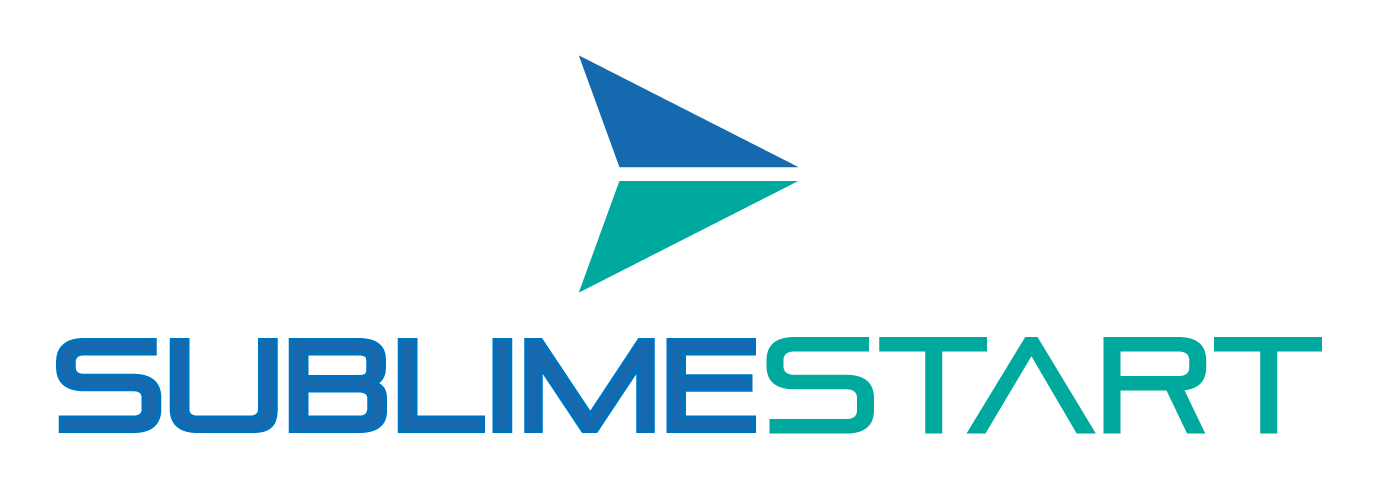Choosing the Best Font Type for Your Brand: Tips and Top Pairings
You’re probably wondering why we chose such a font in the image of this article since font choice is so important. Was it a good choice? Maybe. Are we original? Definitely. The fact is that choosing the right font for a brand is often scary (like “Butcherman”; wink) and we want to share our knowledge.
If you are starting a brand and need to choose a font or you already have a brand but want to improve it you’ll find this guide helpful. We’ll show you the importance of typography in advertising, website and content, typefaces and considerations to make the best choice. We also share the most common mistakes when choosing a font, talk about font pairing (with examples!) and why it’s sometimes wise to work with a designer for your brand. Ready to learn about fonts? Go ahead!
The importance of fonts in brand advertising, website, and content
At SublimeStart, we understand that fonts are more than just design elements—they’re a powerful form of communication. The fonts you choose for your brand’s advertising, website, and content can significantly impact how your audience perceives your business. Let’s see how:
Advertising
In advertising, fonts set the tone before a single word is spoken. A bold, modern font can convey strength and innovation, while a more classic, serif font might suggest tradition and reliability. The choice of font evokes emotions and associations, making it a crucial aspect of your branding strategy.
Website
On your website, fonts are a key factor in user experience. They affect readability, engagement, and even the time visitors spend on your site. A well-chosen font enhances the visual appeal and ensures that your message is communicated clearly and effectively.
Content
When it comes to content, fonts play a vital role in maintaining consistency across all platforms. Whether it’s a blog post, social media update, or printed material, the right font helps create a cohesive brand identity that’s instantly recognizable.
Types of font styles
Font styles are broadly categorized into several key groups, each with its own distinct characteristics and uses. These categories form the foundation of typography, influencing the tone, readability, and overall impact of your brand’s visual identity. By understanding these categories, you can make informed decisions about which font styles best align with your brand’s personality and messaging.
Serif fonts
Serif fonts are characterized by the small lines or strokes attached to the ends of letters. These fonts convey a sense of tradition, reliability, and formality, making them suitable for print materials and formal documents. Examples include Times New Roman, Georgia, and Baskerville.
Common industries that use Serif fonts:
- Publishing (books, newspapers, magazines)
- Legal (law firms, legal documents)
- Financial (banks, financial institutions)
Sans-Serif fonts
Sans-serif fonts lack the additional strokes at the ends of letters, offering a clean, modern, and straightforward appearance. They are highly readable on digital screens and are often used for websites and contemporary branding. Popular examples are Arial, Helvetica, and Verdana.
Common industries that use Sans-Serif fonts:
- Technology (software companies, tech startups)
- Corporate (business websites, corporate branding)
- Healthcare (medical websites, healthcare providers)
Script fonts
Script fonts mimic the fluid strokes of handwriting and calligraphy. They add a personal, elegant, and often luxurious feel to the text. These fonts are ideal for invitations, logos, and decorative purposes. Examples include Brush Script, Pacifico, and Great Vibes.
Common industries that use Script fonts:
- Weddings and Events (invitations, event planning)
- Luxury Goods (jewelry, high-end fashion)
- Hospitality (boutique hotels, upscale restaurants)
Display fonts
Display fonts are highly decorative and attention-grabbing, designed for large headings, posters, and signage. They are not typically used for body text due to their intricate designs. Examples include Impact, Lobster, and Bebas Neue.
Common industries that use Display fonts:
- Advertising (billboards, posters)
- Entertainment (movie posters, album covers)
- Retail (store signage, promotional materials)
Monospace fonts
Monospace fonts have characters that occupy the same amount of horizontal space. This uniformity is reminiscent of typewriter text and is often used in coding, technical documents, and for creating a vintage or retro look. Examples include Courier, Consolas, and Monaco.
Common industries that use Monospace fonts:
- Technology (coding, software development)
- Publishing (technical documentation, manuscripts)
- Gaming (game interfaces, retro games)
Slab Serif fonts
Slab serif fonts feature thick, block-like serifs. They combine the readability of serif fonts with a bold, impactful presence, making them suitable for headlines and logos. Examples include Rockwell, Clarendon, and Museo Slab.
Common industries that use Slab Serif fonts:
- Advertising (headlines, posters)
- Retail (store branding, packaging)
- Automotive (car brands, vehicle advertising)
Handwritten fonts
Handwritten fonts resemble casual handwriting and convey a personal, approachable, and sometimes playful tone. They are often used in creative and informal contexts, such as greeting cards, personal blogs, and social media graphics. Examples include Comic Sans, Indie Flower, and Shadows Into Light. Common industries:
Creative Arts (art blogs, personal websites)
Education (school materials, children’s books)
Food and Beverage (cafes, casual dining)
Blackletter fonts
Blackletter fonts, also known as Gothic or Old English fonts, are characterized by their dramatic, angular lines and elaborate flourishes. These fonts evoke a historical, medieval, or formal feel and are often used in certificates, logos, and headlines. Examples include Old English Text, Fraktur, and Cloister Black.
Common industries that use Blackletter fonts:
- Publishing (historical novels, formal certificates)
- Entertainment (fantasy genres, themed events)
- Breweries (craft beer labels, brewery branding)
Decorative fonts
Decorative fonts are designed with unique, ornamental features that make them stand out. They are used for special projects where a distinct look is required, such as logos, posters, and branding for specific events or products. Examples include Algerian, Jokerman, and Chiller.
Common industries that use Decorative fonts:
- Fashion (clothing brands, fashion magazines)
- Entertainment (concert posters, event branding)
- Food and Beverage (unique product labels, specialty restaurants)
Modern fonts
Modern fonts are characterized by strong vertical stress, minimal contrast between thick and thin strokes, and a contemporary aesthetic. They convey a sense of elegance and forward-thinking. Examples include Futura, Century Gothic, and Avant Garde.
Common industries that use Modern fonts:
- Fashion (high-end brands, fashion magazines)
- Technology (innovative products, tech startups)
- Architecture (modern architectural firms, design magazines)

What is important to consider when choosing a font
As we said before, when selecting fonts for your brand you must ensure that your choices align with your brand’s identity and personality. For example, a tech company might opt for a sleek, modern sans-serif, while a law firm might prefer a traditional serif. To make the font selection process smoother, we listed 10 interesting questions:
1. Does the font reflect my brand’s values and mission?
- Is the font approachable and friendly, or does it convey trustworthiness and professionalism?
- How does the font align with the core mission of your brand?
- Does the font communicate the right message and ethos?
2. Is the font readable and legible across all formats?
- Is the font clear and easy to read in both digital and print formats?
- Does it maintain readability at various sizes, from headings to body text?
- How does it perform on different devices and screen resolutions?
3. Does the font pair well with other fonts in use?
- Does the chosen font complement other fonts used in your branding?
- Is there a clear hierarchy between headings, subheadings, and body text?
- Do the fonts work together to create a cohesive look and feel?
4. Is the font appropriate for my target audience?
- Will the font appeal to your specific target audience?
- Does it create the desired atmosphere and emotional tone?
- How does it resonate with the audience’s expectations and preferences?
5. Does the font support my brand’s visual identity?
- How does the font integrate with other elements of your brand’s visual identity, such as colors, logos, and imagery?
- Is the font style consistent with your brand’s overall aesthetic?
- Does it enhance or detract from your brand’s visual appeal?
6. Is the font versatile for different types of content?
- Can the font be used effectively in various contexts, such as marketing materials, websites, and social media?
- Does it work well for both formal documents and more creative or casual content?
- Is it adaptable for different mediums and applications?
7. Does the font stand the test of time?
- Is the font a timeless choice that won’t quickly become outdated?
- How does it compare to current typography trends?
- Will it maintain its appeal and relevance in the long term?
8. Have I considered the font’s licensing and usage rights?
- Do I have the necessary licenses to use the font in all intended applications?
- Are there any restrictions on how or where the font can be used?
- Is the font freely available, or do I need to budget for a commercial license?
9. How does the font reflect my brand’s personality?
- Does the font convey the right personality traits (e.g., warmth, reliability, creativity)?
- How does the font choice affect the overall tone of your materials?
- Is the font consistent with how you want your brand to be perceived by your audience?
10. Have I gathered feedback on my font choices?
- Have I tested the font choices with a sample of my target audience?
- Have I gathered feedback from stakeholders, such as colleagues or brand experts?
- How does the feedback align with my initial vision and goals for the brand?
The goal is that you can answer these questions so that your choice is as true to your brand as possible and contributes to its growth. However, you might find this process a bit overwhelming. At SublimeStart we are ready to help you improve your brand. Contact us today!
What can go wrong when choosing fonts?
When choosing fonts for your brand, it’s easy to stumble into a few common traps that can throw off your whole look. Maybe you pick something that’s hard to read, or you mix too many different fonts, leaving your brand looking scattered and unprofessional. And while trendy fonts might seem cool at first, they can quickly go out of style, making your brand feel outdated. Plus, a font that looks great on your desktop might not translate well to mobile devices, leading to a frustrating user experience. Here are 5 possible mistakes to correct and choose fonts that really work for your brand:
Ignoring readability and legibility
Choosing fonts that are hard to read is a common mistake. Fonts that are too ornate or have poor spacing can frustrate users and detract from your brand’s professionalism. Always prioritize readability, especially for body text, and test fonts at various sizes and on different devices to ensure clarity.
Failing to consider brand consistency
Using too many different fonts creates a disjointed and unprofessional look. This inconsistency can confuse your audience and weaken your brand identity. Establish clear typography guidelines and stick to them to maintain a cohesive brand presence.
Choosing overly trendy fonts
Trendy fonts may look modern but can quickly become outdated, making your brand appear dated. Instead, choose classic, timeless fonts that retain their appeal over time. Use trendy fonts sparingly for short-term projects.
Neglecting cross-platform compatibility
Fonts that look good on a desktop may not translate well to mobile devices or different screen resolutions. Poor compatibility can lead to a poor user experience. Test your fonts across various platforms to ensure consistent performance, and consider using web-safe fonts.
Overlooking font pairing
Incorrectly pairing fonts can create visual disharmony and affect readability. Clashing styles or weights can be distracting. Look for effective font pairings and use tools to experiment with combinations, ensuring a clear visual hierarchy between headings and body text.
Font pairing: What is it?
We have mentioned it in previous sections and it seems very obvious, but what is it exactly? Font pairing is the art of selecting two or more fonts that complement each other and work well together in a design. The goal is to create a balanced and harmonious look, where each font plays a specific role—like using one font for headings and another for body text.
Good font pairing enhances readability, establishes a clear visual hierarchy, and reinforces your brand’s personality. It’s about finding fonts that contrast enough to be visually interesting but are still cohesive when used together, creating a polished and professional appearance in your branding materials.
5 Tips for successful font pairing
The key to successful font pairing lies in achieving a balance between contrast and harmony. Let’s take a look at 5 fundamental principles to consider:
Contrast
Using fonts that are too similar can make your design look monotonous, while choosing fonts with too much contrast can be jarring. Striking the right balance—such as pairing a bold, strong font with a light, delicate one—creates visual interest and helps guide the reader’s attention.
Hierarchy
Font pairing should establish a clear visual hierarchy, making it easy for your audience to navigate your content. Typically, one font is used for headings, which should be more prominent, while another is used for body text. This distinction helps organize the information and emphasizes the most important elements of your design.
Personality and Tone
Fonts have distinct personalities, and when pairing them, it’s essential to choose ones that align with your brand’s identity and message. For instance, combining a modern sans-serif font with a classic serif can create a sophisticated yet contemporary feel. Ensuring that the paired fonts convey a consistent tone is crucial for maintaining brand integrity.
Readability
No matter how stylish a font combination may be, readability should never be sacrificed. Make sure the fonts you pair are easy to read, especially in longer text blocks or at smaller sizes. This is particularly important for body text, where clarity and legibility are essential.
Compatibility Across Platforms
Different devices and platforms may render fonts differently, so it’s important to choose pairs that are versatile and perform well across various screen sizes and resolutions. Testing your font combinations on multiple devices can help ensure a consistent user experience.
8 great examples of font pairing
Choosing the right font combination can elevate the overall design of your project, making it not only visually appealing but also easier to read. The right pair of fonts can create harmony, balance, and contrast, helping to convey your message effectively. Below are some great examples of font pairings that work well together to achieve just that:
Playfair Display & Montserrat
Playfair Display (serif) for headings and Montserrat (sans-serif) for body text create a classic and modern contrast.
Lora & Source Sans Pro
Lora (serif) pairs nicely with Source Sans Pro (sans-serif) for a clean, professional look.
Raleway & Roboto
Raleway (sans-serif) for headings and Roboto (sans-serif) for body text offer a sleek, minimalist combination.
Merriweather & Open Sans
Merriweather (serif) with Open Sans (sans-serif) creates a versatile and easy-to-read pairing.
Oswald & Lato
Oswald (sans-serif) for titles and Lato (sans-serif) for body text provide a bold and balanced look.
Garamond & Helvetica
Garamond (serif) for a classic touch, combined with Helvetica (sans-serif) for modern readability.
PT Serif & PT Sans
PT Serif (serif) with PT Sans (sans-serif) offers a consistent and cohesive design.
Georgia & Verdana
Georgia (serif) for headings and Verdana (sans-serif) for body text make for a timeless and highly legible pairing.
Sourcing the Perfect Font
When it comes to finding the perfect fonts for your brand or project, there are plenty of resources available online, both free and paid. To help you find the perfect font for your brand, we listed platforms that offer a range of options, from simple, classic fonts to more elaborate, creative designs.
- Google Fonts: One of the most popular sources for free fonts, Google Fonts offers a wide selection of high-quality, open-source fonts that are easy to integrate into websites and other digital projects.
- Adobe Fonts: As part of the Adobe Creative Cloud subscription, Adobe Fonts provides access to a vast library of premium fonts that can be used across various design software.
- Font Squirrel: Font Squirrel is a great resource for free, high-quality fonts that are licensed for commercial use. It’s ideal for designers looking for unique fonts without worrying about licensing issues.
- DaFont: DaFont offers a large collection of fonts, including themed and decorative options. While many fonts on DaFont are free, it’s important to check the licensing terms for each one, especially for commercial projects.
- MyFonts: MyFonts is a popular marketplace for purchasing professional fonts. It offers a wide variety of styles and also has a feature called “WhatTheFont” that helps you identify fonts from images.
- Font Bundles: Font Bundles is known for offering collections of fonts at discounted prices. They frequently have free fonts available, along with premium options for more unique designs.
- Creative Market: Creative Market is another marketplace where you can find both individual fonts and bundles. It’s a great place to discover new and independent font designers.
- Behance: Many designers showcase and share their fonts on Behance, often providing free downloads. It’s also a good place to find inspiration and see how fonts are used in real projects.
Why hire a designer to choose fonts for your brands?
Hiring a designer to choose fonts for your brand can make a significant difference in how your brand is perceived. There are case studies that demonstrate that experienced professionals are more likely to elevate your brand’s visual appeal and create a lasting impression. The reasons? There are many, but we share 3 of them with you:
- Designers have a deep understanding of typography and know how to select fonts that align with your brand’s identity, message, and target audience.
- They can create unique font pairings that enhance readability, establish a clear visual hierarchy, and maintain consistency across all platforms.
- A designer can ensure that your fonts are versatile and compatible across different devices, providing a seamless user experience.
How does a designer choose fonts
The designer’s process in font selection involves certain basic steps that ensures that the chosen fonts are effective and cohesive.
- Research: Understanding the brand’s values, target audience, and competitors.
- Sketching and Iteration: Exploring various font options and refining them.
- Testing: Evaluating fonts in different contexts, such as websites, print materials, and mobile devices.
- Finalization and Implementation: Ensuring consistent use across all brand touchpoints.
Summing Up
Fonts play a crucial role in shaping a brand’s identity. They’re not just about aesthetics; the right font can influence how your audience perceives your brand across advertising, websites, and content. Whether bold or elegant, fonts convey a message before the words are even read, making them a vital tool in your branding strategy.
Remember there are key aspects to consider when choosing fonts and mastering the art of font pairing. You should be careful not to make some common mistakes listed above, but in case you need it you can always hire an experienced designer.
At SublimeStart, we specialize in helping brands find the perfect fonts that align with their identity and resonate with their target audience. Because in the world of digital marketing, every detail counts—and fonts are one detail you can’t afford to overlook.
Are you looking for an expert hand? Don’t hesitate to contact us today! We’ll be glad to help you.






